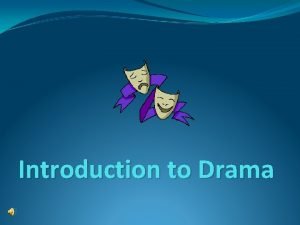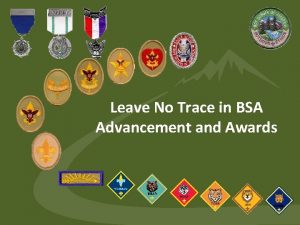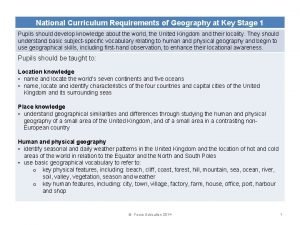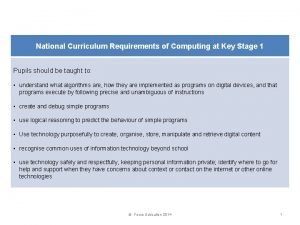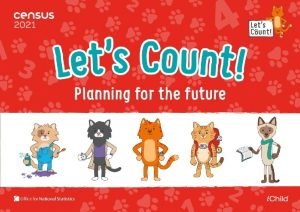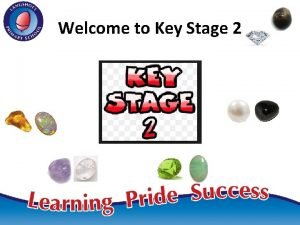National Curriculum Requirements of DT at Key Stage










- Slides: 10

National Curriculum Requirements of DT at Key Stage 1 Through a variety of creative and practical activities, pupils should be taught the knowledge, understanding and skills needed to engage in an iterative process of designing and making. They should work in a range of relevant contexts, (for example the home and school, gardens and playgrounds, the local community, industry and the wider environment). When designing and making, pupils should be taught to: Design • design purposeful, functional, appealing products for themselves and other users based on design criteria • generate, develop, model and communicate their ideas through talking, drawing, templates, mock-ups and, where appropriate, information and communication technology Make • select from and use a range of tools and equipment to perform practical tasks, (or example, cutting, shaping, joining and finishing) • select from and use a wide range of materials and components, including construction materials, textiles and ingredients, according to their characteristics Evaluate • explore and evaluate a range of existing products • evaluate their ideas and products against design criteria Technical knowledge • build structures, exploring how they can be made stronger, stiffer and more stable • explore and use mechanisms, (for example levers, sliders, wheels and axles), in their products. © Focus Education 2014 1

National Curriculum Requirements of Cooking and Nutrition at Key Stage 1 As part of their work with food, pupils should be taught how to cook and apply the principles of nutrition and healthy eating. Instilling a love of cooking in pupils will also open a door to one of the great expressions of human creativity. Learning how to cook is a crucial life skill that enables pupils to feed themselves and others affordably and well, now and in later life. Pupils should be taught to: • use the basic principles of a healthy and varied diet to prepare dishes • understand where food comes from. © Focus Education 2014 2

Knowledge, Skills and Understanding breakdown for Design and Technology Year 1 Developing, planning and communicating ideas • Can they think of some ideas of their own? • Can they explain what they want to do? • Can they use pictures and words to plan? Working with tools, equipment, materials and components to make quality products • Can they explain what they are making? • Can they explain which tools are they using? Evaluating processes and products • Can they describe how something works? • Can they talk about their own work and things that other people have done? Breadth of study Cooking and nutrition • Can they cut food safely? • Can they describe the texture of foods? • Do they wash their hands and make sure that surfaces are clean? • Can they think of interesting ways of decorating food they have made, eg, cakes? Textiles • Can they describe how different textiles feel? • Can they make a product from textiles by gluing? Mechanisms • Can they make a product which moves? • Can they cut materials using scissors? • Can they describe the materials using different words? • Can they say why they have chosen moving parts? © Focus Education 2014 Use of materials • Can they make a structure/model using different materials? • Is their work tidy? • Can they make their model stronger if it needs to be? Construction • Can they talk with others about how they want to construct their product? • Can they select appropriate resources and tools for their building projects? • Can they make simple plans before making objects, e. g. drawings, arranging pieces of construction before building? 3

Knowledge, Skills and Understanding breakdown for Design and Technology Year 2 Developing, planning and communicating ideas • Can they think of ideas and plan what to do next? • Can they choose the best tools and materials? Can they give a reason why these are best? • Can they describe their design by using pictures, diagrams, models and words? Working with tools, equipment, materials and components to make quality products • Can they join things (materials/ components) together in different ways? Evaluating processes and products • Can they explain what went well with their work? • If they did it again, can they explain what they would improve? Breadth of study Cooking and nutrition • Can they describe the properties of the ingredients they are using? • Can they explain what it means to be hygienic? • Are they hygienic in the kitchen? Textiles • Can they measure textile? • Can they join textiles together to make something? • Can they cut textiles? • Can they explain why they chose a certain textile? Mechanisms • Can they join materials together as part of a moving product? • Can they add some kind of design to their product? © Focus Education 2014 Use of materials • Can they measure materials to use in a model or structure? • Can they join material in different ways? • Can they use joining, folding or rolling to make it stronger? Construction • Can they make sensible choices as to which material to use for their constructions? • Can they develop their own ideas from initial starting points? • Can they incorporate some type of movement into models? • Can they consider how to improve their construction? 4

National Curriculum Requirements of DT at Key Stage 2 Through a variety of creative and practical activities, pupils should be taught the knowledge, understanding and skills needed to engage in an iterative process of designing and making. They should work in a range of relevant contexts, for example, the home, school, leisure, culture, enterprise, industry and the wider environment. When designing and making, pupils should be taught to: Design • use research and develop design criteria to inform the design of innovative, functional, appealing products that are fit for purpose, aimed at particular individuals or groups • generate, develop, model and communicate their ideas through discussion, annotated sketches, cross-sectional and exploded diagrams, prototypes, pattern pieces and computer-aided design Make • select from and use a wider range of tools and equipment to perform practical tasks, such as cutting, shaping, joining and finishing, accurately • select from and use a wider range of materials and components, including construction materials, textiles and ingredients, according to their functional properties and aesthetic qualities Evaluate • investigate and analyse a range of existing products • evaluate their ideas and products against their own design criteria and consider the views of others to improve their work • understand how key events and individuals in design and technology have helped shape the world Technical knowledge • apply their understanding of how to strengthen, stiffen and reinforce more complex structures • understand use mechanical systems in their products, (for example as gears, pulleys, cams, levers and linkages) • understand use electrical systems in their products, (for example series circuits incorporating switches, bulbs, buzzers and motors) • apply their understanding of computing to programme, monitor and control their products. © Focus Education 2014 5

National Curriculum Requirements of Cooking and Nutrition at Key Stage 2 As part of their work with food, pupils should be taught how to cook and apply the principles of nutrition and healthy eating. Instilling a love of cooking in pupils will also open a door to one of the great expressions of human creativity. Learning how to cook is a crucial life skill that enables pupils to feed themselves and others affordably and well, now and in later life. Pupils should be taught to: • understand apply the principles of a healthy and varied diet • prepare and cook a variety of predominantly savoury dishes using a range of cooking techniques • understand seasonality, and know where and how a variety of ingredients are grown, reared, caught and processed. © Focus Education 2014 6

Knowledge, Skills and Understanding breakdown for Design and Technology Year 3 Developing, planning and communicating ideas • Can they show that their design meets a range of requirements? • Can they put together a step-by-step plan which shows the order and also what equipment and tools they need? • Can they describe their design using an accurately labelled sketch and words? • How realistic is their plan? Working with tools, equipment, materials and components to make quality products • Can they use equipment and tools accurately? Evaluating processes and products • Can they explain what they changed which made their design even better? Breadth of study Cooking and nutrition • Can they choose the right ingredients for a product? • Can they use equipment safely? • Can they make sure that their product looks attractive? • Can they describe how their combined ingredients come together? • Can they set out to grow plants such as cress and herbs from seed with the intention of using them for their food product? Textiles • Can they join textiles of different types in different ways? • Can they choose textiles both for their appearance and also qualities? Electrical and mechanical components • Do they select the most appropriate tools and techniques to use for a given task? • Can they make a product which uses both electrical and mechanical components? • Can they use a simple circuit? • Can they use a number of components? © Focus Education 2014 Stiff and flexible sheet materials • Do they use the most appropriate materials? • Can they work accurately to make cuts and holes? • Can they join materials? Mouldable materials • Do they select the most appropriate materials? • Can they use a range of techniques to shape and mould? • Do they use finishing techniques? 7

Knowledge, Skills and Understanding breakdown for Design and Technology Year 4 Developing, planning and communicating ideas Working with tools, equipment, materials and components to make quality products • Can they come up with at least one idea about how to create their product? • Do they take account of the ideas of others when designing? • Can they produce a plan and explain it to others? • Can they suggest some improvements and say what was good and not so good about their original design? • Can they tell if their finished product is going to be good quality? • Are they conscience of the need to produce something that will be liked by others? • Can they show a good level of expertise when using a range of tools and equipment? • Do they work at their product even though their original idea might not have worked? Evaluating processes and products • Have they thought of how they will check if their design is successful? • Can they begin to explain how they can improve their original design? • Can they evaluate their product, thinking of both appearance and the way it works? • Do they take time to consider how they could have made their idea better? Breadth of study Cooking and nutrition • Do they know what to do to be hygienic and safe? • Have they thought what they can do to present their product in an interesting way? Textiles • Do they think what the user would want when choosing textiles? • Have they thought about how to make their product strong? • Can they devise a template? • Can they explain how to join things in a different way? Electrical and mechanical components • Can they add things to their circuits? • How have they altered their product after checking it? • Are they confident about trying out new and different ideas? © Focus Education 2014 Stiff and flexible sheet materials • Can they measure carefully so as to make sure they have not made mistakes? • How have they attempted to make their product strong? Mouldable materials • Can they use a range of advanced techniques to shape and mould? • Do they use finishing techniques, showing an awareness of audience? 8

Knowledge, Skills and Understanding breakdown for Design and Technology Year 5 Developing, planning and communicating ideas • Can they come up with a range of ideas after they have collected information? • Do they take a user’s view into account when designing? • Can they produce a detailed step-bystep plan? • Can they suggest some alternative plans and say what the good points and drawbacks are about each? Working with tools, equipment, materials and components to make quality products • Can they explain why their finished product is going to be of good quality? • Can they explain how their product will appeal to the audience? • Can they use a range of tools and equipment expertly? • Do they persevere through different stages of the making process? Evaluating processes and products • Do they keep checking that their design is the best it can be? • Do they check whether anything could be improved? • Can they evaluate appearance and function against the original criteria? Breadth of study Cooking and nutrition • Can they describe what they do to be both hygienic and safe? • How have they presented their product well? Textiles • Do they think what the user would want when choosing textiles? • How have they made their product attractive and strong? • Can they make up a prototype first? • Can they use a range of joining techniques? Electrical and mechanical components • Can they incorporate a switch into their product? • Can they refine their product after testing it? • Can they incorporate hydraulics and pneumatics? © Focus Education 2014 Stiff and flexible sheet materials • Are their measurements accurate enough to ensure that everything is precise? • How have they ensured that their product is strong and fit for purpose? Mouldable materials • Are they motivated enough to refine and further improve their product using mouldable materials? 9

Knowledge, Skills and Understanding breakdown for Design and Technology Year 6 Developing, planning and communicating ideas Working with tools, equipment, materials and components to make quality products • Can they use a range of information to inform their design? • Can they use market research to inform plans? • Can they work within constraints? • Can they follow and refine their plan if necessary? • Can they justify their plan to someone else? • Do they consider culture and society in their designs? • Can they use tools and materials precisely? • Do they change the way they are working if needed? Evaluating processes and products • How well do they test and evaluate their final product? • Is it for purpose? • What would improve it? • Would different resources have improved their product? • Would they need more or different information to make it even better? • Does their product meet all design criteria? • Did they consider the use of the product when selecting materials? Breadth of study Cooking and nutrition • Can they explain how their product should be stored with reasons? • Can they set out to grow their own products with a view to making a salad, taking account of time required to grow different foods? Textiles • Have they thought about how their product could be sold? • Have they given considered thought about what would improve their product even more? Electrical and mechanical components • Can they use different kinds of circuit in their product? • Can they think of ways in which adding a circuit would improve their product? © Focus Education 2014 Stiff and flexible sheet materials • Can they justify why they selected specific materials? • How have they ensured that their work is precise and accurate? • Can they hide joints so as to improve the look of their product? Mouldable materials • Can they justify why the chosen material was the best for the task? • Can they justify design in relation to the audience? 10







